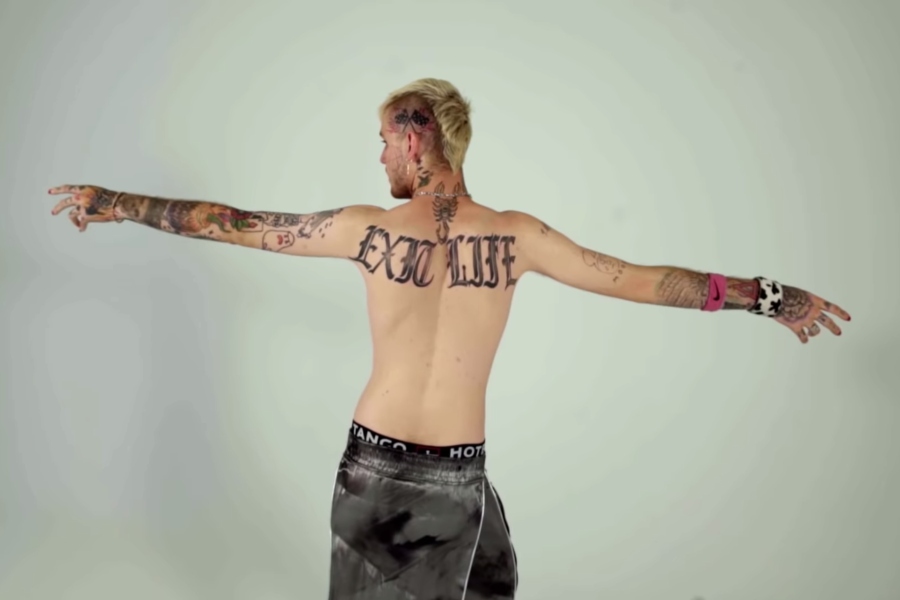Near the end of Everybody’s Everything, a new documentary about the late emo rap phenom Lil Peep, his mother Liza Womack breaks the fourth wall. “All of this,” she says, tearfully gesturing at the film crew, “holding onto him, holding onto him, not letting go.” She struggles to complete the thought: that retelling Peep’s story reinforces her grief. The documentary, which Womack executive produced, traces the artist born Gustav Åhr’s rapid rise to fame, the explosion of the DIY scene from which he rose, and his death two years ago at the age of 21. At first, the storytelling is fairly traditional, but the final act pulls back, as Peep’s family, friends, and collaborators discuss the documentary itself: the motives behind participating, the implications of its release. Peep died on his tour bus, of an accidental overdose of fentanyl and Xanax, and last month, Womack sued his management team for negligence. Her choked-up moment depicts the tragic limits of narrative resolution.
Womack executive produced the film alongside Sarah Stennett, the head of Peep’s talent agency and record label, First Access Entertainment, which Womack has since sued. (The film premiered in March, seven months before the lawsuit was filed.) The other executive producer was Terrence Malick, the visionary director, who befriended Womack’s father and Peep’s grandfather, the historian and Harvard professor John Womack, as an undergraduate student in the 1960s. Liza Womack recruited Malick to steward the film, and Malick handpicked filmmaker Sebastian Jones to co-direct with Ramez Silyan, one of Peep’s music video directors. Malick also introduced Jones and Silyan to a series of letters that John Womack sent to Peep throughout his life, which Womack reads aloud in the film for the first time since he wrote them. Peep, known as Gus to his loved ones, brought the letters with him when he moved from Long Island to Los Angeles in 2016, and when he moved back home.
Everybody’s Everything details Peep’s final hours, but mostly focuses on his music career, from his early days recording in his childhood bedroom under the name Trap Goose, to his post-breakthrough period living in London, where he started recording with iLoveMakonnen and walking in runway shows, to his ill-fated last tour. It’s a particularly strong document of how various like-minded teenagers connected on SoundCloud, started throwing low-budget shows, and built an underground movement of metal and emo-inflected hip-hop—a movement which Peep outgrew, the documentary argues, in ways with which he struggled to cope. Several of the scene’s undersung artists receive time to reflect. Two notable subjects declined interviews, the directors told me in a phone interview: Peep’s father, who divorced Womack when Peep was 14, and Belinda Mercer, the tour manager whom Womack’s lawsuit accuses of providing the artist drugs.

Also Read
Pop-Punk and Hip-Hop: 2020’s Dynamic Duo
The documentary, and an accompanying album featuring unreleased Lil Peep songs, receives a national release today, November 15, two years to the day after Peep’s 2017 death. Everybody’s Everything delights in showing how Peep earned his heartthrob buzz, and speculates about the roots of his drug abuse, reminding viewers of the sad truth that speculation is the only thing available to his loved ones. I suspect that many of the interviewees will relate to Liza Womack in not totally finding catharsis from the story being told.
The elliptical title is drawn from the caption of an Instagram post Peep published on the day before his death, which the filmmakers were drawn to as a possible window into his mindset at the end of his life: “I just wana be everybody’s everything.” The following conversation with directors Sebastian Jones and Ramez Silyan has been edited for length and clarity.
SPIN: What inspired the use of John Womack’s letters as a framing device?
SEBASTIAN JONES: Terry [Malick] told me that Jack wrote these letters, these long letters to Gus. Liza told me he took them with him to LA and they were very important to him. I wanted to use them, structurally speaking, to make it feel almost like Jack is like this guardian angel of sorts. His letters usually come in at low points in Gus’ life, in darker times, or he’s feeling lost: like in the beginning, when his music isn’t quite working out the way he wants it to, or later, with the divorce. But it works on an emotional level to lift you out of these darker times, to make you feel, in a way, perhaps the way Gus might’ve felt reading them. In speaking to Emma Harris, his girlfriend, she told us that he would read these letters, and underline certain parts, and re-read them.
RAMEZ SILYAN: Once we were made aware of them, it was a no-brainer. It was like, whoa. You stumble on this trove of emotional wealth that you can’t not share. In one letter, Jack wrote to Gus, ask yourself what being a man is. And they just finally released some new songs of Gus’s, and he has a song called “Belgium” where the refrain is literally, “Ask yourself.” So you’re starting to see how he was thinking. If he’s getting this letter and keeping it close to his heart and it comes out in his music—the importance is just there, you can’t really ignore it.
They’re also just beautiful letters. Honestly, hearing them, they’re the types of letters everyone wishes they got, you know what I mean? This mentor that’s teaching you about life in a very respectful way. Some of the letters that Jack wrote Gus are when he was a kid, and he’s treating him, really, like a peer. It’s beautiful.
The film features a lot of footage that Gus filmed of himself as he documented his own rise across the internet. How did you approach the question of the film’s perspective?
JONES: There was obviously a wealth of material to pull from, and we tried to keep our quota up of moments where Gus is speaking himself. That’s important, because you get connected. You don’t want to just see a person’s image, you want to see them speak.
In terms of looking for a way into the story, the title of the film, Everybody’s Everything, is incredibly important. Before we started on it, I came across that phrase when I was doing a little bit of research. That really jumped out at me, that he said that just before he died. I was immediately curious about, what did he mean by that? What led him to this point at which he says something like this? And who are these people? Who’s this everybody that he’s speaking to? Who are the people in his life? So I was immediately more curious about the social dynamics of his life and all the people he knew, and so that was like the guiding principle: this idea of him wanting to be everybody’s everything.
Watching this made me think of a quote from a German writer, “A man who dies at the age of 35 is at every point of his life a man who dies at the age of 35.” How did you navigate the trap of framing Gus’ death as inevitable?
JONES: I didn’t want it to be a story just about that he died young. He had so much going on in his life that was so fascinating—even just the influence of his family, their political influence in his life, the way he thought about the world, and how he grew up in that. There were plenty of other things to talk about. It wasn’t too hard. It’s incredibly sad that he died young, but there was a lot going on his life. We had a lot of other things to talk about that were more important and more interesting than just reducing it down to a story of a person that died young.
SILYAN: The narrative of “he died young” is the narrative that a lot of other people have been fascinated with, and that’s just a shame. The point of this film is to go beyond that. We’re trying to show you who this person was and who he would’ve continued to become.
How did outstanding questions about Gus’ death and various subjects’ potential legal liabilities influence the film?
JONES: First Access and Liza [Womack] were both co-financiers of the film. So everybody had their input. When you’re dealing with telling a story about someone’s life like this, it’s important to get all this input, because you want to get it right. It’s a serious responsibility. But yeah, First Access wasn’t micromanaging things, and I had creative control. The pressures didn’t affect the storytelling. Certainly, people had strong opinions, naturally, in a situation like this.
SILYAN: I wouldn’t say it affected the process, but we were learning a lot as we were speaking to people. There were definitely, like Sebastian said, strong opinions—people not making accusations, but speaking to what maybe they witnessed, or they saw, or they were involved in. We weren’t aware of the full scale of what is going on now with the lawsuit. There was definitely some talk of this person did this or this person did that, but not to the extent of what you saw in [Rolling Stone‘s] reporting. It wasn’t the focus.

What are your hopes for the film?
JONES: I hope that people that maybe wrote Gus off give him a second chance and are surprised by what they find. I hope that people get to know him through this, and get to understand him better. Because I think he was misunderstood by a lot of people, and it’s really sad, because he was such a special person.
SILYAN: The goal is for people to see past that initial judgment that they made, whether purposefully or not, when they saw a photo of him, or heard of his passing, or heard his song. I was recently flying to New York, and I was wearing my Peep hoodie. One of the TSA agents was like, Lil Peep, huh? I just kind of looked at him and I was like, Oh, you don’t like him? You’re not a fan? He just kind of chuckled and I moved my bins along. For me, it’s like, I want that guy to see the movie, ’cause I know he’s not gonna have that same attitude when he comes out. Or, I hope.
Correction: An earlier version of this story incorrectly identified Sarah Stennett as a defendant in Liza Womack’s wrongful death lawsuit.




